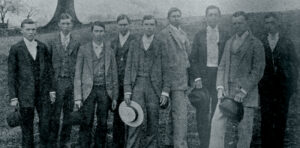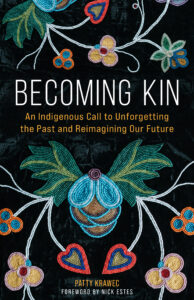Indigenous Removals and Their Legacies: A Reading Guide to Start Campus Conversations
Helen Makhdoumian is a Collaborative Humanities Postdoctoral Program Fellow with the Department of English.

Last semester at Vanderbilt, I attended talks for “Cherokee and Chickasaw Students at Vanderbilt, 1885-1899,” a library exhibit organized by Professor Daniel Sharfstein, and the panel “The Land We Occupy: Vanderbilt Past and Present,” organized by the RPW Center’s Spatial Histories seminar. During the Q&As, I witnessed the energy for further conversation on campus. I write this as a resource for anyone interested in thinking through the questions raised during these events. In opening remarks for the RPW panel, for instance, Professor Sara Safransky invited audience members to imagine “how to better acknowledge these histories” and “what right living means in the context of this knowledge.”
Conceptual Frameworks
Several conceptual frameworks for the study of collective memory can facilitate discussions about dark pasts. These include “settler memory” from Kevin Bruyneel and “directional memory,” which Mishuana Goeman (Tonawanda Band of Seneca) adapts from poet Esther Belin (Diné). Additionally, Lee Maracle (Stó꞉lō Nation) identifies practices of “re-membering” in her oratories. Literary texts which address remembrance practices include National Monuments by poet Heid E. Erdrich (Turtle Mountain Band of Ojibwe).
Removal
On the topic of removal, I recommend the novel The Removed by Brandon Hobson (Cherokee Nation of Oklahoma). In part, Hobson confronts racist imagery of Native peoples in video games. Regarding the Trail of Tears, the memoir Poet Warrior by Joy Harjo (Mvskoke/Creek) describes Oklahoma as a place which “began as a kind of refugee camp for Natives moved at gunpoint from the East, followed by droves of settlers.”
In my undergraduate course this Spring, “The Repair Work of Righting and Writing,” I will teach from Becoming Kin: An Indigenous Call to Unforgetting the Past and Reimagining Our Future by Patty Krawec (Lac Seul First Nation). Krawec teaches readers about the aftermaths of removals, including contestations over collective memory and the formation of new communal relationships in the face of dispersion. Moreover, Krawec guides readers to comprehend the overlaps and distinctions between experiences of migration for immigrants and refugees, Indigenous peoples, and arrivants that so define the history of the nation-state.
contestations over collective memory and the formation of new communal relationships in the face of dispersion. Moreover, Krawec guides readers to comprehend the overlaps and distinctions between experiences of migration for immigrants and refugees, Indigenous peoples, and arrivants that so define the history of the nation-state.
I’ll also teach the poem “38” from Whereas by Layli Long Soldier (Oglala Lakota).The poem’s speaker contemplates memorialization practices while correcting settler rhetoric about historical events: the hanging of the thirty-eight Dakota men, an order signed by then President Abraham Lincoln, and the exile of Dakota from their homelands. Whereas resonates with Standing with Standing Rock: Voices from the #NoDAPL Movement, which we’ll also take up.
Indian Boarding Schools
In 2021, US Secretary of the Interior Deb Haaland (Pueblo Laguna) announced the Department’s initiative to uncover the truth about US federal Indian boarding schools. The statement emerged around the same time as newspaper headlines regarding the discovery of unmarked graves at residential schools in Canada. To broach these exigent issues unfolding outside the classroom, one can turn to the dystopian young adult novels The Marrow Thieves (2017) and Hunting by Stars (2021) by Cherie Dimaline (Georgian Bay Métis) or to the creative non-fiction book Genocidal Love: A Life After Residential School (2020) by Bevann Fox (Pasqua First Nation). The latter lends itself nicely to discussion on the topics of recognition, reconciliation, and reparation taken up by Audra Simpson (Mohawk of Kahnawà:ke) and Glen Coulthard (Yellowknives Dene) in their critical writings on “refusal” and “grounded normativity,” respectively.
Different Forms of Displacement
Some Indigenous studies scholars use “removal” as an encompassing term to address different forms of displacement beyond its traditional usage to mean territorial dispossession. Kathryn Walkiewicz (Cherokee Nation) writes of the “logic of Indigenous and Black exclusion” in the formation of statehood. Leanne Betasamosake Simpson (Michi Saagiig Nishnaabeg) makes the case for the terminology of “expansive dispossession,” or removal “from the present” and “relationships that are meaningful…politically and otherwise,” in her work on “resurgence theory.” These texts can be taught alongside what Jean M. O’Brien (White Earth Ojibwe) identifies as the processes of “firsting and lasting,” or the narrativization of American Indian extinction through the trope of the “vanishing Indian,” as well as what O’Brien and Lisa Blee call the “monumental mobility” of the Cyrus E. Dallin statue Massasoit.
Here’s to future conversations on campus inspired by these and other publications, many of which are available in the Vanderbilt library system and are hyperlinked accordingly.
 Helen Makhdoumian is a literary studies scholar who takes up a relational approach to theorize the legacies of collective violence in the Middle East and in North America. In so doing, she expands upon discourses in trauma, memory, and genocide studies, as well as diaspora, transnational, and migration studies. Her book project, Nested Memory and the After-Words of Removal, focuses on multigenerational transmissions of memory in the face of the recursivity of collective trauma. It features contemporary texts by Armenian American, Palestinian American, American Indian, and First Nations authors. She holds a PhD in English from the University of Illinois, Urbana-Champaign.
Helen Makhdoumian is a literary studies scholar who takes up a relational approach to theorize the legacies of collective violence in the Middle East and in North America. In so doing, she expands upon discourses in trauma, memory, and genocide studies, as well as diaspora, transnational, and migration studies. Her book project, Nested Memory and the After-Words of Removal, focuses on multigenerational transmissions of memory in the face of the recursivity of collective trauma. It features contemporary texts by Armenian American, Palestinian American, American Indian, and First Nations authors. She holds a PhD in English from the University of Illinois, Urbana-Champaign.